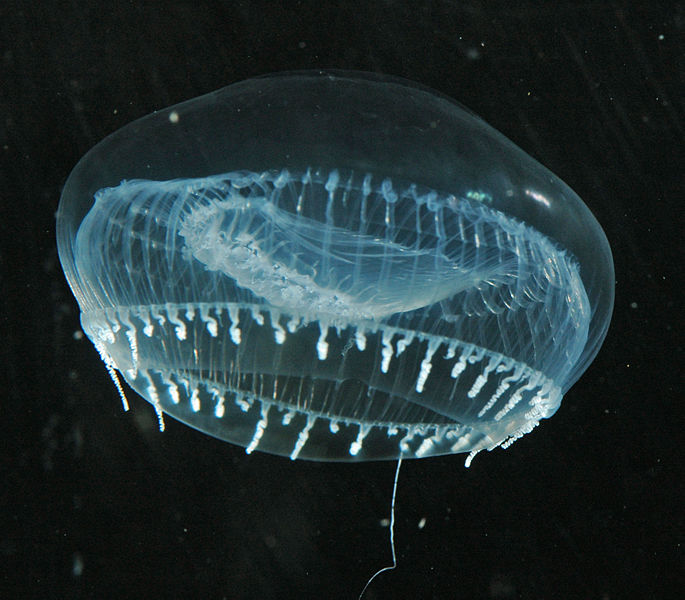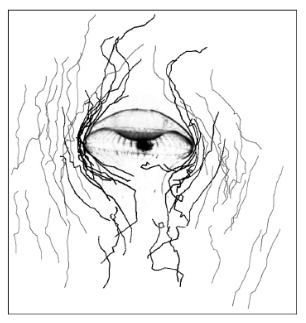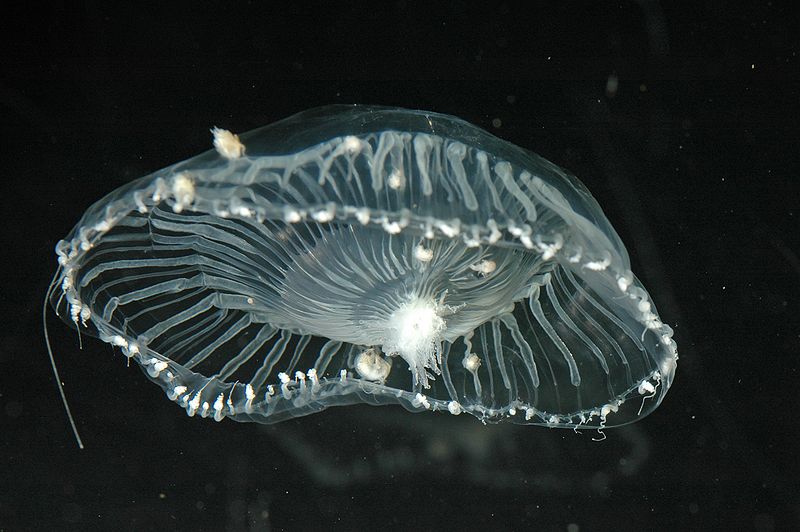Form & Function
Aequorea victoria is commonly described as an umbrella shaped
organism. The top of the organism is known as the umbrella
or bell, and the underside of the umbrella is known as the
subumbrella (Shimomura, 1999). It is also motile in its medusa
form only (click here for
information on medusa life stage). Understanding the general body plan of a jellyfish
like Aequorea victor ia
is crucial for understanding how the form of the body relates to
the function of the organisms structures.
ia
is crucial for understanding how the form of the body relates to
the function of the organisms structures.
The swimming action of the medusa form is actually quite complicated and unique in Aequorea victoria. According to a recent study by Dr. Richard Satterlie, Aequorea victoria are capable of utilizing only parts of their muscular swimming tissues at certain times, such as using part of their radial muscle for swimming and feeding at the same time (Satterlie, 2008). This adaptation could be quite advantageous to the survivability of Aequorea victoria. For example, if Aequorea victoria needed to stop swimming in order to eat its prey, it may be vulnerable to attacks by predators because it is stationary.
Organisms living in aquatic environments similar to the Pacific
Ocean require osmoregulation adaptations, so not surprisingly
Aequorea victoria has developed adaptations
to
survive in differentiating water conditions. In a study by Dr. Claudia E. Mills,
Aequorea
victoria and other hydromedusae were put in solutions of higher and
lower salinity than normal seawater, lowering and raising water
concentrations respectively. Initially the organisms would
float at the surface in lower salt conditions and sink to the bottom
in higher salt conditions. Once Aequorea
victoria was able to equilibrate with its new environment, it swam as usual. However, during this
equilibration period the studied hydromedusae, including Aequorea
victoria, generally contracted in what could be described as a
protective manner analogous to fetal positioning in humans, but soon
after resumed normal swimming (Mills, 1984). These results
agree with the osmotic potential that would be present across the
cell membranes of Aequorea victoria in these solutions. This
reaction to its enviornment is a behavior in the sense that a stimulus
occurred, and the organism adapted to the stimulus before resuming
normal function. These observations not only show that Aequorea victoria is able to adapt to stimuli, but also that it may alter its behavior until normal conditions are restored.
This may be an area for potential further research into the ability
of jellyfish like Aequorea victoria to recognize and adapt to
enviornmental stimuli.
environment, it swam as usual. However, during this
equilibration period the studied hydromedusae, including Aequorea
victoria, generally contracted in what could be described as a
protective manner analogous to fetal positioning in humans, but soon
after resumed normal swimming (Mills, 1984). These results
agree with the osmotic potential that would be present across the
cell membranes of Aequorea victoria in these solutions. This
reaction to its enviornment is a behavior in the sense that a stimulus
occurred, and the organism adapted to the stimulus before resuming
normal function. These observations not only show that Aequorea victoria is able to adapt to stimuli, but also that it may alter its behavior until normal conditions are restored.
This may be an area for potential further research into the ability
of jellyfish like Aequorea victoria to recognize and adapt to
enviornmental stimuli.
Figure 1. "Prey tracks around Aequorea victoria in the laboratory. Black tracks: prey that are entrained and encountered (or pass through tentacles); gray tracks: prey not encountered by the medusa" (Kataji et al., 2011).
There is another interesting relationship present in Aequorea
victoria between body shape, swimming, and feeding. Aequorea
victoria is classified as having an oblate medusa form. Oblate
means a sphere flattened at the poles similar to the shape of a ball
being forcibly stepped on. This oblate shape has implications
for both motility and feeding. Multiple studies have come to
the same convergent concl usion:
the swimming pattern of Aequorea victoria is a slow constant motion
(Satterlie, 2008; Colin & Costello, 2001). This process of swimming
in Aequorea victoria is characterized as a series of contractions of
the circular muscles that surround the bell of the organism
(Satterlie, 2008). These contractions flush water out of the
subumbrellar cavity in a manner analogous to jet propulsion (click
here for an organism that has developed jet propulsion movement
through convergent evolution) creating the slow graceful motion
pattern seen in oblate medusae such as Aequorea victoria (Satterlie,
2008; Colin & Costello, 2001). This slow constant motion
creates directional currents due to vortex effects that direct
potential food into the trailing tentacles of Aequorea victoria
(Kataji et al., 2011; Colin & Costello, 2001). This vortex
phenomenon is clearly visible in Aequorea victoria when tracking
water movement around Aequorea victoria as it swims (fig. 1).
usion:
the swimming pattern of Aequorea victoria is a slow constant motion
(Satterlie, 2008; Colin & Costello, 2001). This process of swimming
in Aequorea victoria is characterized as a series of contractions of
the circular muscles that surround the bell of the organism
(Satterlie, 2008). These contractions flush water out of the
subumbrellar cavity in a manner analogous to jet propulsion (click
here for an organism that has developed jet propulsion movement
through convergent evolution) creating the slow graceful motion
pattern seen in oblate medusae such as Aequorea victoria (Satterlie,
2008; Colin & Costello, 2001). This slow constant motion
creates directional currents due to vortex effects that direct
potential food into the trailing tentacles of Aequorea victoria
(Kataji et al., 2011; Colin & Costello, 2001). This vortex
phenomenon is clearly visible in Aequorea victoria when tracking
water movement around Aequorea victoria as it swims (fig. 1).
Knowledge of the motile stage of Aequorea victoria is important in understanding how the organism feeds in its medusa form, but Aequorea victoria does not always feed while it swims. For more information about the rest of the life cycle of Aequorea victoria click the Life History Button below.
